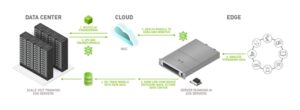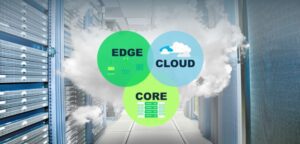Multi-access edge computing. Server computing power has traditionally been utilised to execute activities such as data reduction or the creation of complex distributed systems. Such ‘intelligent’ operations are handled by servers in the cloud model so that they may be moved to other devices with little or no computational capacity.

Why Edge Cloud?
Edge cloud shifts a large portion of these processing chores to the client side, which is known as Edge Computing for Enterprises. Edge Network computing often refers to IoT devices, but it may also apply to gaming hardware that processes telemetry on the device rather than transmitting it to the cloud. This opens up several potentials for enterprises, particularly when it comes to providing low-latency services across apps or high-density platform utilisation using Multi-access edge computing.
Why is an edge to cloud connectivity required?
The increased requirement for real-time data-driven decision-making, particularly by Edge Computing for Enterprises, is one driver of today’s edge-to-cloud strategy (Pastor-Vargas et al., 2020). For example, autonomous vehicle technologies rely on artificial intelligence (AI) and machine learning (ML) systems that can discern whether an item on the roadway is another car, a human, or road debris in a fraction of a second.

What is an edge-to-cloud platform?
An edge-to-cloud platform is intended to provide a Cloud Computing technology and experience to all of an organization’s apps and data, independent of location. It provides a uniform user experience and prioritizes security in its design. It also enables enterprises to seek new business prospects by providing new services with a point-and-click interface and easy scalability to suit changing business demands.
How is an edge-to-cloud platform work?
To provide a cloud experience everywhere, a platform must have certain distinguishing features:
Self-service: Organizations want the ability to swiftly and simply spin up resources for new initiatives, such as Edge Computing for Enterprises, new virtual machines (VMs), or container or MLOps services. Users may pick and deploy the cloud services they require with a single click.
Rapid scalability: To deliver on the cloud’s promise of agility, a platform must incorporate built-in buffer capacity, so that when additional capacity is required, it is already installed and ready to go (Osia et al., 2018).
Pay-as-you-go: Payment should be based on the real capacity used, allowing firms to launch new initiatives without incurring large upfront expenses or incurring procurement delays.
Managed on your behalf: An edge-to-cloud platform should alleviate the operational load of monitoring, updating infrastructure and utilising Multi-access edge computing, allowing IT to concentrate on growing the business and producing revenue.

Why is an edge-to-cloud approach required?
Organizations throughout the world are embracing digital transformation by using Edge Computing for Enterprises, but in many cases, their existing technological infrastructure must be re-examined to meet the needs of data growth, Edge networks, IoT, and remote workforces (Nezami et al., 2021). A single experience with the same agility, simplicity, and pay-per-use flexibility across an organization’s whole hybrid IT estate is provided via an edge-to-cloud strategy and Multi-access edge computing. This implies that enterprises no longer have to make concessions to operate mission-critical programmes, and essential enterprise data services may now access both on-premises and public Cloud Computing technology resources.
What does this signify for your network design?
By merging Edge Computing for Enterprises and Cloud Computing technology, you may make use of the power of distributed systems by processing data on devices that then transfer it to the cloud. It can be processed, analysed, or saved here with minimal (or even no) processing power. Because of an Edge Network and cloud architecture, linked automobiles that exchange information, for example, may analyse data without relying on a server’s processing capability.
What are the Advantages of Edge -to- Cloud Computing technology?
Organizations benefit from the edge-to-cloud experience in several ways:
· Increase agility: Edge Networks and cloud solutions enable enterprises to respond rapidly to business needs, capitalise on market opportunities as they occur, and reduce time to market for new products.
· Application modernization: Even mission-critical workloads that are not suitable for moving to the public cloud may be performed efficiently on today’s as-a-service platforms.
· Make use of the capabilities of hybrid cloud systems without complications: The edge-to-cloud platform provides the benefits of hybrid cloud adoption and Multi-access edge computing without the associated administrative issues. The user experience of applications operating on an as-a-service platform remains consistent.
· With Edge-to-Cloud Computing technology, enterprises can simply establish the ideal blend of on- and off-premises assets and swiftly move between them when business and market conditions change (Milojicic, 2020).
Recognize the transformative power of applications and data:
Some data sets are either too vast or too important to migrate to the cloud.
View the blog in video format!






